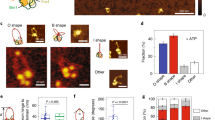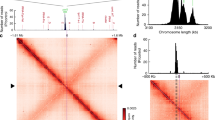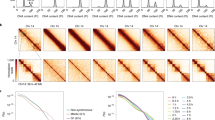Abstract
The multisubunit condensin complex is essential for the structural organization of eukaryotic chromosomes during their segregation by the mitotic spindle, but the mechanistic basis for its function is not understood. To address how condensin binds to and structures chromosomes, we have isolated from Saccharomyces cerevisiae cells circular minichromosomes linked to condensin. We find that either linearization of minichromosome DNA or proteolytic opening of the ring-like structure formed through the connection of the two ATPase heads of condensin's structural maintenance of chromosomes (SMC) heterodimer by its kleisin subunit eliminates their association. This suggests that condensin rings encircle chromosomal DNA. We further show that release of condensin from chromosomes by ring opening in dividing cells compromises the partitioning of chromosome regions distal to centromeres. Condensin hence forms topological links within chromatid arms that provide the arms with the structural rigidity necessary for their segregation.
This is a preview of subscription content, access via your institution
Access options
Subscribe to this journal
Receive 12 print issues and online access
$189.00 per year
only $15.75 per issue
Buy this article
- Purchase on Springer Link
- Instant access to full article PDF
Prices may be subject to local taxes which are calculated during checkout







Similar content being viewed by others
References
Lewis, C.D. & Laemmli, U.K. Higher order metaphase chromosome structure: evidence for metalloprotein interactions. Cell 29, 171–181 (1982).
Hirano, T. & Mitchison, T.J. A heterodimeric coiled-coil protein required for mitotic chromosome condensation in vitro. Cell 79, 449–458 (1994).
Hirano, T., Kobayashi, R. & Hirano, M. Condensins, chromosome condensation protein complexes containing XCAP-C, XCAP-E and a Xenopus homolog of the Drosophila Barren protein. Cell 89, 511–521 (1997).
Strunnikov, A.V., Hogan, E. & Koshland, D.E. SMC2, a Saccharomyces cerevisiae gene essential for chromosome segregation and condensation, defines a subgroup within the SMC family. Genes Dev. 9, 587–599 (1995).
Saka, Y. et al. Fission yeast cut3 and cut14, members of a ubiquitous protein family, are required for chromosome condensation and segregation in mitosis. EMBO J. 13, 4938–4952 (1994).
Sutani, T. et al. Fission yeast condensin complex: essential roles of non-SMC subunits for condensation and Cdc2 phosphorylation of Cut3/SMC4. Genes Dev. 13, 2271–2283 (1999).
Bhat, M.A., Philp, A.V., Glover, D.M. & Bellen, H.J. Chromatid segregation at anaphase requires the barren product, a novel chromosome-associated protein that interacts with Topoisomerase II. Cell 87, 1103–1114 (1996).
Oliveira, R.A., Coelho, P.A. & Sunkel, C.E. The condensin I subunit Barren/CAP-H is essential for the structural integrity of centromeric heterochromatin during mitosis. Mol. Cell. Biol. 25, 8971–8984 (2005).
Hagstrom, K.A., Holmes, V.F., Cozzarelli, N.R. & Meyer, B.J. C. elegans condensin promotes mitotic chromosome architecture, centromere organization, and sister chromatid segregation during mitosis and meiosis. Genes Dev. 16, 729–742 (2002).
Hirota, T., Gerlich, D., Koch, B., Ellenberg, J. & Peters, J.-M. Distinct functions of condensin I and II in mitotic chromosome assembly. J. Cell Sci. 117, 6435–6445 (2004).
Gerlich, D., Hirota, T., Koch, B., Peters, J.M. & Ellenberg, J. Condensin I stabilizes chromosomes mechanically through a dynamic interaction in live cells. Curr. Biol. 16, 333–344 (2006).
Griese, J.J., Witte, G. & Hopfner, K.-P. Structure and DNA binding activity of the mouse condensin hinge domain highlight common and diverse features of SMC proteins. Nucleic Acids Res. 38, 3454–3465 (2010).
Onn, I., Aono, N., Hirano, M. & Hirano, T. Reconstitution and subunit geometry of human condensin complexes. EMBO J. 26, 1024–1034 (2007).
Nasmyth, K. & Haering, C. Cohesin: its roles and mechanisms. Annu. Rev. Genet. 43, 525–558 (2009).
Anderson, D.E., Losada, A., Erickson, H.P. & Hirano, T. Condensin and cohesin display different arm conformations with characteristic hinge angles. J. Cell Biol. 156, 419–424 (2002).
Kimura, K. & Hirano, T. ATP-dependent positive supercoiling of DNA by 13S condensin: a biochemical implication for chromosome condensation. Cell 90, 625–634 (1997).
Kimura, K., Rybenkov, V.V., Crisona, N.J., Hirano, T. & Cozzarelli, N.R. 13S condensin actively reconfigures DNA by introducing global positive writhe: implications for chromosome condensation. Cell 98, 239–248 (1999).
Stray, J.E., Crisona, N.J., Belotserkovskii, B.P., Lindsley, J.E. & Cozzarelli, N.R. The Saccharomyces cerevisiae Smc2/4 condensin compacts DNA into (+) chiral structures without net supercoiling. J. Biol. Chem. 280, 34723–34734 (2005).
Bazett-Jones, D.P., Kimura, K. & Hirano, T. Efficient supercoiling of DNA by a single condensin complex as revealed by electron spectroscopic imaging. Mol. Cell 9, 1183–1190 (2002).
Kimura, K., Hirano, M., Kobayashi, R. & Hirano, T. Phosphorylation and activation of 13S condensin by Cdc2 in vitro. Science 282, 487–490 (1998).
Kimura, K., Cuvier, O. & Hirano, T. Chromosome condensation by a human condensin complex in Xenopus egg extracts. J. Biol. Chem. 276, 5417–5420 (2001).
Yoshimura, S.H. et al. Condensin architecture and interaction with DNA: regulatory non-SMC subunits bind to the head of SMC heterodimer. Curr. Biol. 12, 508–513 (2002).
Sakai, A., Hizume, K., Sutani, T., Takeyasu, K. & Yanagida, M. Condensin but not cohesin SMC heterodimer induces DNA reannealing through protein-protein assembly. EMBO J. 22, 2764–2775 (2003).
Hirano, T. At the heart of the chromosome: SMC proteins in action. Nat. Rev. Mol. Cell Biol. 7, 311–322 (2006).
Haering, C.H., Farcas, A.-M., Arumugam, P., Metson, J. & Nasmyth, K. The cohesin ring concatenates sister DNA molecules. Nature 454, 297–301 (2008).
Ivanov, D. & Nasmyth, K. A topological interaction between cohesin rings and a circular minichromosome. Cell 122, 849–860 (2005).
Lavoie, B.D., Tuffo, K.M., Oh, S., Koshland, D.E. & Holm, C. Mitotic chromosome condensation requires Brn1p, the yeast homologue of Barren. Mol. Biol. Cell 11, 1293–1304 (2000).
Freeman, L., Aragon-Alcaide, L. & Strunnikov, A.V. The condensin complex governs chromosome condensation and mitotic transmission of rDNA. J. Cell Biol. 149, 811–824 (2000).
Ouspenski, I.I., Cabello, O.A. & Brinkley, B.R. Chromosome condensation factor Brn1p is required for chromatid separation in mitosis. Mol. Biol. Cell 11, 1305–1313 (2000).
Yong-Gonzalez, V., Wang, B.-D., Butylin, P., Ouspenski, I. & Strunnikov, A. Condensin function at centromere chromatin facilitates proper kinetochore tension and ensures correct mitotic segregation of sister chromatids. Genes Cells 12, 1075–1090 (2007).
Guacci, V., Hogan, E. & Koshland, D.E. Chromosome condensation and sister chromatid pairing in budding yeast. J. Cell Biol. 125, 517–530 (1994).
Lavoie, B.D., Hogan, E. & Koshland, D.E. In vivo requirements for rDNA chromosome condensation reveal two cell-cycle-regulated pathways for mitotic chromosome folding. Genes Dev. 18, 76–87 (2004).
Haering, C.H., Löwe, J., Hochwagen, A. & Nasmyth, K. Molecular architecture of SMC proteins and the yeast cohesin complex. Mol. Cell 9, 773–788 (2002).
Ivanov, D. & Nasmyth, K. A physical assay for sister chromatid cohesion in vitro. Mol. Cell 27, 300–310 (2007).
Hudson, D.F. et al. Molecular and genetic analysis of condensin function in vertebrate cells. Mol. Biol. Cell 19, 3070–3079 (2008).
Stray, J.E. & Lindsley, J.E. Biochemical analysis of the yeast condensin Smc2/4 complex: an ATPase that promotes knotting of circular DNA. J. Biol. Chem. 278, 26238–26248 (2003).
Lavoie, B.D., Hogan, E. & Koshland, D.E. In vivo dissection of the chromosome condensation machinery: reversibility of condensation distinguishes contributions of condensin and cohesin. J. Cell Biol. 156, 805–815 (2002).
Hudson, D.F., Vagnarelli, P., Gassmann, R. & Earnshaw, W.C. Condensin is required for nonhistone protein assembly and structural integrity of vertebrate mitotic chromosomes. Dev. Cell 5, 323–336 (2003).
Wang, B.-D., Eyre, D., Basrai, M., Lichten, M. & Strunnikov, A.V. Condensin binding at distinct and specific chromosomal sites in the Saccharomyces cerevisiae genome. Mol. Cell Biol. 25, 7216–7225 (2005).
D'Ambrosio, C. et al. Identification of cis-acting sites for condensin loading onto budding yeast chromosomes. Genes Dev. 22, 2215–2227 (2008).
Brito, I.L., Yu, H.-G. & Amon, A. Condensins promote co-orientation of sister chromatids during Meiosis I in budding yeast. Genetics 185, 55–64 (2010).
Ono, T., Fang, Y., Spector, D.L. & Hirano, T. Spatial and temporal regulation of Condensins I and II in mitotic chromosome assembly in human cells. Mol. Biol. Cell 15, 3296–3308 (2004).
Jäger, H., Rauch, M. & Heidmann, S. The Drosophila melanogaster condensin subunit Cap-G interacts with the centromere-specific histone H3 variant CID. Chromosoma 113, 350–361 (2005).
Samoshkin, A. et al. Human condensin function is essential for centromeric chromatin assembly and proper sister kinetochore orientation. PLoS ONE 4, e6831 (2009).
Ribeiro, S.A. et al. Condensin regulates the stiffness of vertebrate centromeres. Mol. Biol. Cell 20, 2371–2380 (2009).
Coelho, P.A., Queiroz-Machado, J. & Sunkel, C.E. Condensin-dependent localisation of topoisomerase II to an axial chromosomal structure is required for sister chromatid resolution during mitosis. J. Cell Sci. 116, 4763–4776 (2003).
Bhalla, N., Biggins, S. & Murray, A.W. Mutation of YCS4, a budding yeast condensin subunit, affects mitotic and nonmitotic chromosome behavior. Mol. Biol. Cell 13, 632–645 (2002).
D'Ambrosio, C., Kelly, G., Shirahige, K. & Uhlmann, F. Condensin-dependent rDNA decatenation introduces a temporal pattern to chromosome segregation. Curr. Biol. 18, 1084–1089 (2008).
Renshaw, M.J. et al. Condensins promote chromosome recoiling during early anaphase to complete sister chromatid separation. Dev. Cell 19, 232–244 (2010).
Gruber, S. et al. Evidence that loading of cohesin onto chromosomes involves opening of its SMC hinge. Cell 127, 523–537 (2006).
He, X., Asthana, S. & Sorger, P.K. Transient sister chromatid separation and elastic deformation of chromosomes during mitosis in budding yeast. Cell 101, 763–775 (2000).
Alexandru, G., Uhlmann, F., Mechtler, K., Poupart, M.A. & Nasmyth, K. Phosphorylation of the cohesin subunit Scc1 by Polo/Cdc5 kinase regulates sister chromatid separation in yeast. Cell 105, 459–472 (2001).
Straight, A.F. et al. Net1, a Sir2-associated nucleolar protein required for rDNA silencing and nucleolar integrity. Cell 97, 245–256 (1999).
Michaelis, C., Ciosk, R. & Nasmyth, K. Cohesins: chromosomal proteins that prevent premature separation of sister chromatids. Cell 91, 35–45 (1997).
Acknowledgements
We thank J. Ellenberg, M. Knop, A.-C. Gavin and all members of the Haering group for advice and discussions, K. Nasmyth (University of Oxford) for strains and plasmids, D. Ivanov for sharing protocols, and the staff of the European Molecular Biology Laboratory (EMBL) Advanced Light Microscopy, Flow Cytometry and Genomics Core facilities for their assistance. This work was supported by funding from EMBL and the German Research Foundation (DFG) Priority Programme 1384 (C.H.H.).
Author information
Authors and Affiliations
Contributions
S.C., J.M. and C.H.H., yeast strain and plasmid generation; S.C., minichromosome, co-immunoprecipitation and ChIP-qPCR experiments; S.C. and J.M., live-cell imaging experiments; C.H.H., chromosome spreads; S.C. and C.H.H., project design and manuscript preparation; C.H.H., project supervision.
Corresponding author
Ethics declarations
Competing interests
The authors declare no competing financial interests.
Supplementary information
Supplementary Text and Figures
Supplementary Figures 1–5, Supplementary Tables 1 and 2, and Supplementary Methods (PDF 4948 kb)
Rights and permissions
About this article
Cite this article
Cuylen, S., Metz, J. & Haering, C. Condensin structures chromosomal DNA through topological links. Nat Struct Mol Biol 18, 894–901 (2011). https://doi.org/10.1038/nsmb.2087
Received:
Accepted:
Published:
Issue Date:
DOI: https://doi.org/10.1038/nsmb.2087
This article is cited by
-
A mitotic chromatin phase transition prevents perforation by microtubules
Nature (2022)
-
Genome folding through loop extrusion by SMC complexes
Nature Reviews Molecular Cell Biology (2021)
-
Chromosome organization in bacteria: mechanistic insights into genome structure and function
Nature Reviews Genetics (2020)
-
Topological DNA-binding of structural maintenance of chromosomes-like RecN promotes DNA double-strand break repair in Escherichia coli
Communications Biology (2019)
-
Condensin action and compaction
Current Genetics (2019)



